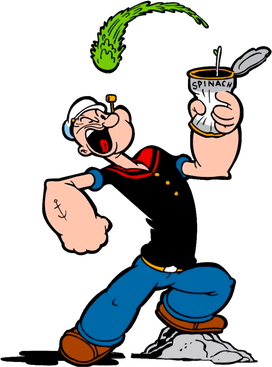
Even now, many people believe that spinach is an excellent source of iron and that Popeye the Sailor Man had superhuman strength because he feasted on it. Smart though uneducated, he was supposed to know how to solve difficult problems, and although he did not smoke tobacco, he ate spinach through his pipe. He would have been anticipated some 2,000 years earlier by the Persians, who exported the “Persian vegetable” to India, Nepal, and China. The Saracens took it to Sicily, and by 1200 AD it had already reached the English cookbooks as “spinnedge.”
Spinach is eaten raw as a salad or cooked in dishes such as the Greek spanakopita. It tastes best pureed with garlic and an egg on top of it, as served in some central European restaurants. Delicious as it might be, it has been the subject of many unsubstantiated claims, promoted as a superstar among green leafy vegetables; low in calories; full of fiber, folate, and vitamins; able to boost hydration; curb appetite, strengthen the immune system, and prevent osteoporosis; good for baby, good for your eyes, good for your heart, for diabetes, for cancer, and for Parkinson’s disease. Some of these results might require eating unrealistic, huge quantities; but nevertheless, spinach juice judiciously fortified with wine was given to injured French soldiers in the Second World War; Joe Louis ate it, and so did all the famous boxers of their time, Gene Tunney and Max Schmeling.
Spinach’s major claim to fame is that it contains a lot of iron. But already by 1981, T.J. Hamblin pointed out that this was based on erroneous scientific data, useful propaganda for the meatless days of World War II, and even more so for the spinach growers who erected a statue of Popeye in Crystal City, Texas, because single-handedly Popeye had raised the consumption of spinach by 33%.1 Hamblin pointed out that claims for the high content of iron in spinach were based on the work of 19th century scientists, including possibly (according to legend2–4) the one who erroneously put the decimal point in the wrong place and made a tenfold overestimate of its value. Hamblin concluded that spinach was no better a source of iron than cabbage, Brussels sprouts, or broccoli; that Popeye would have done better chewing the cans it came in; and that regrettably “frauds, fakes, and widely popularized mistakes run through the warp and woof of the history of science and medicine.”1
A more recent review also points out that E.C. Seger, the creator of Popeye, did not have him eat spinach for iron but in 1932 explained it was a good source of vitamin A.2 Reliable scientific data indicates that most of the iron in spinach is contained in higher molecular weight compounds and not absorbed. One hundred grams of spinach contain as much iron as 100 g of sirloin steak, but only 1.7% of iron from spinach is absorbed compared to 20% from steak.3 Reference has also been made to the fact that in the 19th and 20th century idiom “it’s spinach” meant it is nonsense or rubbish.4
As raw spinach contains over four times the recommended daily intake of vitamin K, the intake spinach should be limited in patients taking the anticoagulant warfarin. Spinach also contains large amounts of oxalates, which could block the absorption of calcium from the stomach and small intestine and in theory could promote the formation of kidney stones and interact with some medications. It has been said to aggravate the symptoms of gout and if consumed in huge amounts may cause bloating, gas, cramps, and diarrhea.
In recent years contaminated spinach has caused several E. coli and Salmonella food poisoning outbreaks. In 2006 over 100 cases were reported in 30 US states and the FDA issued a warning not to eat it uncooked or fresh because bags of fresh organic spinach had become tainted by irrigation water contaminated with pig feces. With better public health measures, spinach remains poised as the superstar of green leafy vegetables, but even that is a matter of taste and opinion.
References
- Hamblin T.J. “Fake!” BMJ, December 1981;283:1671.
- Sutton M. “How the spinach, Popeye, and iron decimal point error myth was finally bust.” Health Watch Newsletter 2016;101:7. www healthwatch-uk.org.
- Schwarcz J. “Iron in Spinach.” Office for Science and Society, McGill University, March 20, 2017. www.mcgill.ca/oss/article/food-health-news-quirky-science/setting-facts-straight-about-iron-spinach.
- Mielewcwik M & Moll J. “Spinach in Blunderland: how the myth that spinach is rich in iron became an urban academic legend.” Annals of the History and Philosophy of Biology 2016;21:61-142. www.researchgate.net/publication/331556841_Spinach_in_Blunderland_How_the_myth_that_spinach_is_rich_in_iron_became_an_urban_academic_legend.

Leave a Reply